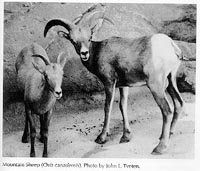Mountain Sheep (Ovis canadensis)

TPWD ©
- Description
- Mountain Sheep are large, brown sheep with heavy, curved horns and a conspicuous white rump patch.
- Life History
Bighorn sheep rest at night on steep, rocky slopes, on top of rocky rims, or on a slope between two bluffs. These types of areas give them excellent protection from predators, since they enable the sheep to see in all directions except uphill. If a predator approached from uphill, falling rocks would warn the Mountain Sheep and give them time to escape. The animals tend to bunch together at night. Mountain Sheep do not line their bedding areas with anything. They sleep on bare ground, and beds that are frequently used have feces and a strong urine odor.
The diet of bighorn sheep depends on seasonal availability of the plants they eat. Typical desert plants such as sotol, yucca, and ocotillo are popular, as are prickly pear and wild onions. Bighorns are well-adapted to the dry areas in which they live. They rarely need water. They appear to get sufficient water from the green and succulent vegetation on which they feed.
During breeding season beginning in November, male Mountain Sheep (rams) begin fighting for mates. Smaller, weaker males often cannot compete with the older, stronger ones. Rams move from flock to flock to mate with available females (ewes). Their lambs are born in late spring and early summer. Ewes usually have just one lamb, but sometimes they have twins. When they are born, the lambs are weak and helpless. But they mature quickly, so that just one week after birth, they are able to see and walk.
- Habitat
- Mountain Sheep are inhabitants of rugged, mountainous terrain. They prefer bluffs and steep slopes with sparse vegetation and an unobstructed view.
- Distribution
- These sheep formerly lived in the isolated mountain ranges of Trans-Pecos Texas, but native populations were wiped out from the state in 1959, when the total population was estimated at 14. Mountain Sheep were recently re-introduced in protected areas of their former native range, and now there are once again small, wild populations in these areas.